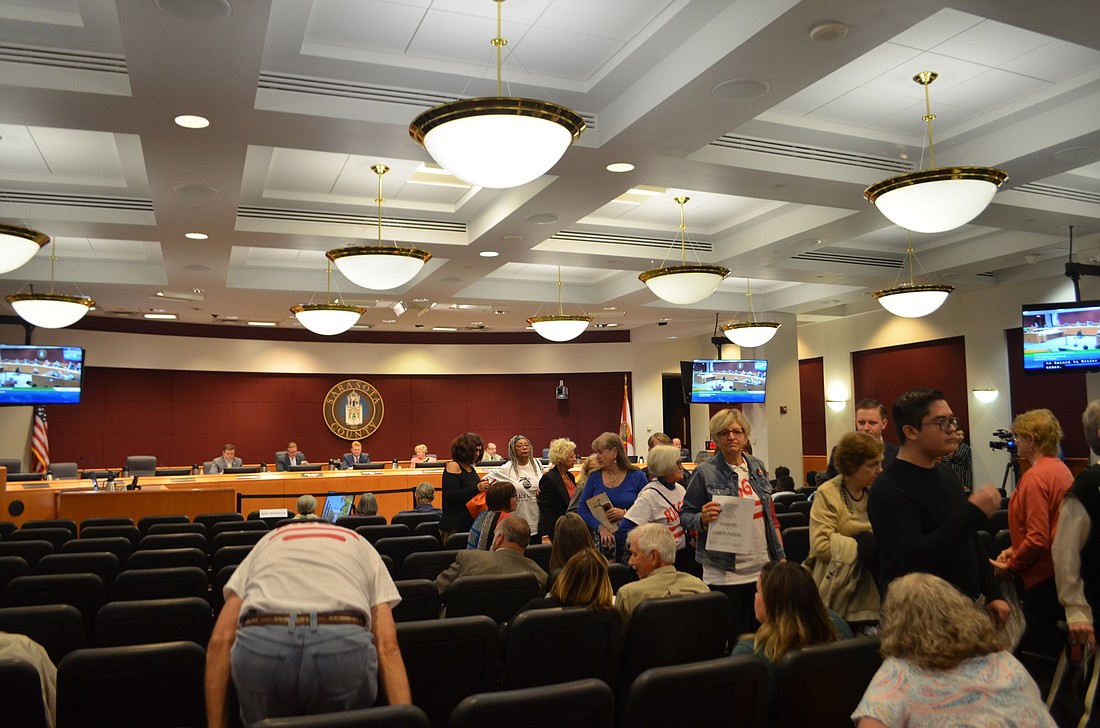- March 30, 2025
-
-
Loading

Loading

When it became clear the Sarasota County Commission intended to approve a controversial map outlining new district boundaries, most of the audience in attendance began to exit the commission chambers amid murmurs of disapproval.
“Let’s walk out guys,” resident Wilson Pava said. “They’re not listening.”
Despite opposition at Tuesday’s meeting, the County Commission voted 3-2 to select new district outlines ahead of the 2020 census and election cycle. The chosen map, identified as Map 4.1, is based on a concept submitted by former Republican Party of Sarasota County Chairman Bob Waechter.
The commissioners who supported Map 4.1 — Nancy Detert, Al Maio and Mike Moran — said it satisfied several of the criteria they had for a new district map. They reiterated their belief that redistricting was necessary to create more balanced district boundaries ahead of a voter-backed shift to a single-member district electoral system.
“What I would look for is what’s legal: compact districts, contiguous districts and communities of interest should be kept together,” Detert said.
But ahead of the vote, members of the public urged the commission to reconsider the redistricting effort and questioned the motives behind the initiative. Speakers said the proposal would disenfranchise voters in the African American community of Newtown in north Sarasota by shifting the neighborhood from District 1, where a commission seat is up for election in 2020, to District 2, where a vote will not be held until 2022.
During the meeting, Sarasota City Commissioner Shelli Freeland Eddie read from a segment of a city-adopted resolution opposing the redistricting effort. The resolution acknowledged that a shift from countywide elections for all five commission seats would inevitably restrict the ability of some residents to vote in the 2020 elections, but it criticized any map that would affect all of Newtown in that manner.
“It is incomprehensible how elected officials could deliberately cause this to happen unnecessarily to a community which for so long encountered such tremendous obstacles to voting, including but not limited to harassment, intimidation and economic reprisals,” Freeland Eddie said.
Redistricting critics continued to question the population projections used, encouraging the commission to wait until updated census data becomes available. Speakers also suggested the all-Republican County Commission was conducting a partisan gerrymandering effort before 2020.
The adopted map is an adjusted version of one Waechter submitted anonymously to the county. Waechter’s role in the process has drawn criticism, both for his partisan alignment and his personal history. In 2013, Waechter pleaded guilty to making fraudulent campaign contributions under then-County Commission candidate Lourdes Ramirez’s name.
Both Detert and Moran attempted to place some distance between Waechter and Map 4.1. Detert said the boundaries in Waechter’s map were adjusted by consultant Kurt Spitzer, whom the county hired to lead the redistricting effort. But Spitzer noted his firm had not drawn the map, only adjusted the boundaries to ensure more balanced populations in each district. Spitzer said the methodology behind Map 4.1 differed from the three maps he first presented to the county.
“All of the three maps we had originally drawn were drawn to more typical redistricting principles,” Spitzer said.
Moran rejected the characterization of Map 4.1 as one based on Waechter’s proposal.
“On repeated occasions, this map has been erroneously identified,” Moran said. “While this might make good content for newspaper articles, it’s flatly untrue.”
Moran instead said it was an evolution of what he characterized as a conceptually similar map first presented by Jono Miller, who previously ran for County Commission as a Democrat.
After the meeting, Spitzer confirmed Map 4.1 was directly derived from one Waechter submitted. Miller said the adopted map differed meaningfully from the maps he submitted.
“I personally don’t see the connection,” Miller said.
Freeland Eddie and other speakers alluded to the possibility of legal action attempting to block the adoption of Map 4.1. County Commissioner Christian Ziegler, who has opposed the redistricting effort, cited that as one of the reasons he preferred to adopt an alternate map drawn by the redistricting consultant the county hired, identified as 2-A.1.
In response to questions from Ziegler, a county attorney said Map 4.1 presented legal issues that are not present in 2-A.1, though he said he did not want to get into details in a public setting.
Ziegler said he believed the county began the redistricting process only to modestly adjust the existing map to create a better balance between districts, and that Map 4.1 was a dramatic change the board hadn’t adequately considered.
“Map 4 is a focus on completely redrawing the entire county based on geography,” Ziegler said.
But the majority of the commission was comfortable with moving forward with Map 4.1, with Detert suggesting some of the community concern should instead be targeted at the new election system.
“Part of the criticisms are really based on the effects of single-member districts,” Detert said. “We’re not taking away anybody’s right to vote on any of these maps.”
The county must take additional procedural steps to finalize the adoption of the maps. That process is scheduled to be completed Dec. 13.